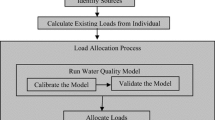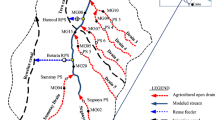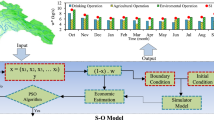Abstract
Effective water quality management requires careful consideration of pollutant fate and transport, proper estimation of non-point source loadings, and maximum allowable allocation of point source discharges. A decision support system (DSS) that addresses all these issues is developed in this study by embedding mass-balance expressions, GIS, and a remote-sensing-based non-point source loading scheme into a hybrid goal-programming approach and is applied to the rapidly growing Arroyo Colorado River watershed along the US–Mexico border. The model components were favorably evaluated against field data and previous studies. The DSS was used to evaluate the carrying capacity of the river, defined based on the water quality standards for biochemical oxygen demand, dissolved oxygen, and minimum in-stream flow requirements. The results indicated that on a macro-scale, the current stresses utilize about 40 % of the maximum carrying capacity. However, the most upstream and downstream sub-watersheds are currently over stressed and need to reduce their loadings. The assimilative capacity of the river is not sufficient to carry current flows at their permitted discharge concentrations implying an inequity among discharges with regard to treatment cost burden. Sensitivity analyses indicated that the carrying capacity was more affected by policy choices made for water quality standards then where they were to be enforced (i.e., compliance locations). Urban areas currently cover 13 % of the watershed but contribute nearly 45 % of the total non-point source loadings. Therefore, the urbanization in this watershed must be carefully planned with emphasis on stormwater treatment and management to sustain this valuable resource for future generations.







Similar content being viewed by others

References
ACWP (2007) A watershed protection plan for the arroyo Colorado—Phase I. Arroyo Colorado Watershed Partnership, http://www.arroyocolorado.org/watershed-protection-plan/. Accessed Dec 2011
Arbabi M, Elzinga J (1975) A general linear approach to stream water quality modeling. Water Resour Res 11(2):191–196
Behera PK, Adams BJ, Li JY (2006) Runoff quality analysis of urban catchments with analytical probabilistic models. J Water Resour Plan Manag 132(1):4–14
Bitton G (1998) Formula handbook for environmental engineers and scientists. Wiley, New York
Briendenbach J, Seo DJ, Fulton R (1998) Stage II and stage III post processing of NEXRAD precipitation estimates in the modernized weather service. In: AMS 78th annual meeting, Phoenix
Brown LC, Barnwell TO (1987) The enhanced stream water quality models Qual2e and Qual2e-Uncas: documentation and user manual. Environmental Research Laboratory, U.S. EPA, Athens
Burn DH (1989) Water quality management through combined simulation–optimization approach. J Environ Eng 115:1011–1024
Burn DH, McBean EA (1985) Optimization modeling of water quality in an uncertain environment. Water Resour Res 21(7):934–940
Cardwell H, Ellis H (1993) Stochastic dynamic programming models for water quality management. Water Resour Res 29(4):803–817
Chapra SC (1997) Surface water quality modeling. McGraw-Hill, New York
Chapra SC, Canale RP (2002) Numerical methods for engineers: with software and programming applications. McGraw-Hill, New York
Charbeneau RJ, Barrett ME (1998) Evaluation of methods for estimating stormwater pollutant loads. Water Environ Res 70(7):1295–1302
Di Toro DM (1979) Statistics of receiving water response to runoff. In: Urban stormwater and combined sewer overflow impact on receiving water bodies, national conference, University of Central Florida, Orlando
Edgar TF, Himmelblau DM, Lasdon LS (2001) Optimization of chemical processes. McGraw-Hill, New York
Ewing R, Bartholomew K, Winkelman S, Walters J, Chen D (2007) Growing cooler: evidence on urban development and climate change. Urban Land Institute, Washington
Harr ME (1987) Reliability-based design in civil engineering. McGraw-Hill, New York
Hattis D, Anderson EL (1999) What should be the implications of uncertainty, variability, and inherent “biases”/“conservatism” for risk management decision-making? Risk Anal 19(1):95–107
Hernandez EA (2007) Risk based methodologies for watershed management: integrated simulation and optimization techniques. Dissertation, Texas A&M University—Kingsville, Kingsville
Hernandez E, Uddameri V (2010) Selecting agricultural best management practices for water conservation and quality improvements using Atanassov’s intuitionistic fuzzy sets. Water Resour Manag 24(15):4589–4612
IBWC (2005) “2005 annual report.” International Boundary and Water Commission, www.ibwc.gov/Organization/Public_Affairs.html. Accessed 11 Dec 2011
ICCMA, SGN (2006) This is smart growth [Brochure]. EPA 231-K-06-002, International City/County Management Association, and Smart Growth Network
Korfmacher KS (1998) Water quality modeling for environmental management: lessons from the policy sciences. Policy Sci 31:35–54
Korfmacher KS (2001) The politics of participation in watershed modeling. Environ Manag 27(2):161–176
Kouwen N (1988) Watflood: a micro-computer based flood forecasting system based on real-time weather radar. Can Water Resour J 13(1):62–77
Stubbs MJ, Rister ME, Sturdivant AW, Lacewell, RD (2005) An overview of operational characteristics of selected irrigation districts in the Texas Lower Rio Grande Valley: Hidalgo County Irrigation District No. 2 (San Juan). Texas A&M University, College Station
León LF, Soulis ED, Kouwen N, Farquhar GJ (2001) Nonpoint source pollution: a distributed water quality modeling approach. Water Res 35(4):997–1007
Leopold LB, Maddock T (1953) The hydraulic geometry of stream channels and some physiographic implications. U. S. Geological Survey, Washington, DC
Lin JP (2004) Review of published export coefficient and event mean concentration (Emc) data. U.S. Army Corps of Engineers, Wetlands Regulatory Assistance Program
Lindenschmidt K-E (2006) The effect of complexity on parameter sensitivity and model uncertainty in river water quality modelling. Ecol Model 190:72–86
Lohani BN, Thanh NC (1979) Probabilistic water quality control policies. J Environ Eng 105(4):713–725
Lung W-S, Sobeck RG Jr (1999) Renewed use of Bod/Do models in water quality management. J Water Resour Plan Manag 125(4): 222–227
Malano HM, Davidson B (2009) A framework for assessing the trade-offs between economic and environmental uses of water in a river basin. Irrig Drain 58(S1):S133–S147
Marsalek J (1991) Pollutant loads in urban stormwater: review of methods for planning level estimates. Water Resour Bull 27(2):283–291
Mitchell G (2005) Mapping hazard from urban non-point pollution: a screening model to support sustainable urban drainage planning. J Environ Manag 74:1–9
Mujumdar PP, Sasikumar K (2002) A fuzzy risk approach for seasonal water quality management of a river system. Water Resour Res 38:51–59
Mujumdar P, Saxena P (2004) A stochastic dynamic programming model for stream water quality management. Sadhana 29(5):477–497
Murty YSR, Bhallamudi SM, Srinivasan K (2006) Non-uniform flow effect on optimal waste load allocation in rivers. Water Resour Manag 20:509–530
Nas SS, Nas E (2009) Water quality modeling and dissolved oxygen balance in streams: a point source Streeter–Phelps application in the case of the Harsit stream. Clean Soil Air Water 37(1):67–74
NCDC (2006) NCDC—image and publications system. National Climatic Data Center. http://www7.ncdc.noaa.gov/IPS/. Accessed June 2006
NRC, CASB, WSTB (2001) Assessing the Tmdl approach to water quality management. National Research Council, Committee to Assess the Scientific Basis of the Total Maximum Daily Load Approach to Water Pollution Reduction, and Water Science and Technology Board. National Academy Press, Washington, DC
Oreskes N, Shrader-Frechette K, Belitz K (1994) Verification, validation, and confirmation of numerical models in the earth sciences. Science 263:641–646
Orlob GT (1983) Mathematical modeling of water quality: streams, lakes, and reservoirs. Wiley, New York
Pollard OA (2000) Smart growth: the promise, politics, and potential pitfalls of emerging growth management strategies. Copyright (c) 2000 Virginia Environmental Law Journal Association Virginia Environmental Law Journal
Qin X, Huang G, Chen B, Zhang B (2009) An interval-parameter waste-load-allocation model for river water quality management under uncertainty. Environ Manag 43(6):999–1012
Raines TH, Miranda RM (2002) Simulation of flow and water quality of the arroyo Colorado, Texas, 1989–1999. Water-Resources Investigations Report 02-4110, U.S. Geological Survey, Austin, Texas
Reckhow KH, Butcher JB, Marin CM (1985) Pollutant runoff models: selection and use in decision making. Water Resour Bull 21(2):185–195
Revelle CS, Loucks DP, Lynn WP (1968) Linear programming applied to water quality management. Water Resour Res 4(1):1–9
RGRWPG (2011) Region M 2011 Water Plan. Rio Grande Regional Water Planning Group. riograndewaterplan.org/waterplan.php. Accessed 28 Dec 2011
Sasikumar K, Mujumdar PP (1998) Fuzzy optimization model for water quality management of a river system. J Water Resour Plan Manag 124:79–88
Sethi SJ, Arriola RS (2002) Targeting the future: a report about the evolving labor market in Texas’ Rio Grande Valley. Tech Prep of the Rio Grande Valley, Inc. for CBIRD-Texas Regional Action Council
Streeter HW, Phelps EB (1925) A study of the pollution and natural purification of the Ohio River. Public Health Bulletin 146, U.S. Public Health Service, Washington, DC, pp 127–146
Takyi AK, Lence BJ (1999) Surface water quality management using a multiple-realization chance constraint method. Water Resour Res 35:1657–1670
TCEQ (2006a) Pollutant reduction plan for the arroyo colorado: segments 2201 and 2202, Hidalgo, Cameron, and Willacy Counties. Texas Commission on Environmental Quality. www.tceq.state.tx.us/assets/public/implementation/water/tmdl/13arroyo/13-arroyo_prp_july2006.pdf. Accessed Aug 2006
TCEQ (2006b) Sampling data query, surface water quality monitoring. Texas Commission on Environmental Quality. http://www.tceq.state.tx.us/compliance/monitoring/crp/data/samplequery.html. Accessed June 2006
TCEQ (2008) 2008 Texas 303(D) List (March 19, 2008). Texas Commission on Environmental Quality. http://www.tceq.texas.gov/waterquality/assessment/08twqi/twqi08.html. Accessed Dec 2011
TCEQ (2010) Draft 2010 Texas 303(D) List (February 5, 2010). Texas Commission on Environmental Quality. http://www.tceq.texas.gov/waterquality/assessment/10twqi/10twqi. Accessed Dec 2011
Thomann RV, Mueller JA (1987) Principles of water quality modeling and control. Harper and Row Publishers, New York
Vasquez JA, Maier HR, Lence BJ, Tolson BA, Foschi RO (2000) Achieving water quality system reliability using genetic algorithms. J Environ Eng 126(10):954–962
Webler T, Tuler S, Dietz T (2011) Modellers’ and outreach professionals’ views on the role of models in watershed management. Environ Policy Gov 21(6):472–486
Acknowledgments
This material is based upon work supported by NSF under Cooperative Agreement No. HRD-0206259. Any opinions, findings, and conclusions or recommendations expressed in this material are those of the author and do not necessarily reflect the views of the National Science Foundation. The authors would like to thank Javier Davila for his data collection efforts. In addition, the authors would like to thank Theodore G. Cleveland for his editorial review and the anonymous reviewers for the constructive criticism, both of which enhanced the clarity and readability of this paper.
Author information
Authors and Affiliations
Corresponding author
Rights and permissions
About this article
Cite this article
Hernandez, E.A., Uddameri, V. An assessment of optimal waste load allocation and assimilation characteristics in the Arroyo Colorado River watershed, TX along the US–Mexico border. Clean Techn Environ Policy 15, 617–631 (2013). https://doi.org/10.1007/s10098-012-0546-6
Received:
Accepted:
Published:
Issue Date:
DOI: https://doi.org/10.1007/s10098-012-0546-6



